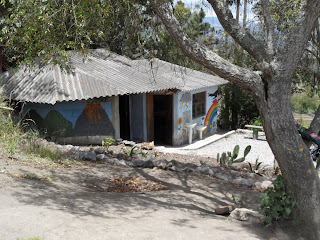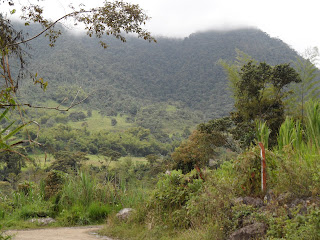 |
| Volcan Tungurahua, and that is steam, not a cloud, at the top. The Volcano has had two serious eruptions the past 12 years and spouts off a little hot air from time to time. |
Salasaca, the pueblo that is home to Escuela Katitawa, is a very spread out community of 2,000 people divided into smaller districts, nestled between Ambato (the fourth largest city in Ecuador) and Baños (named for baths, not bathrooms) in the central highlands. The elevation here is about 9,000 feet, so while it gets warm when the sun is out during the day, evenings are fairly chilly, though not cold.
 |
| A woman in traditional Kichwa garb spins wool as she walks, a very common occupation. Often they will spin the wool while loaded down with big bundles of grass to feed the livestock -- multitasking, Ecuador style. |
The area is beautiful and the view from the hilltops is incredible, as
is the case for much of Ecuador. On a clear day we have a view of the
highest mountain (Chimborazo) and highest volcano (Tungurahua) in
Ecuador. Both are close to 20,000 feet.
 |
| The view (on a rare clear day) from the balcony. Chimborazo is the tallest mountain in Ecuador. Below is Ambato, about 20 kilometers away. |
"Central Salasaca" and I chuckle even using that term, is about three blocks worth of shops along the highway. Most of the people live east of the main road, working on farms. There is a second paved road that heads East, and one that branches off from there down a large hill to another group of farms nearer the stream.
 |
| This bridge is kind of the designated marker for "Central Salasaca" which is really just the junction of the two paved roads. |
 |
| Looking down road No. 1, the one that goes toward Baños |
 |
| This is the other road, the one that heads toward the rest of Salasaca, including the library and the hostel. |
Transportation is by collectivo (pickup trucks), and a dime will save you a 20-minute walk down the other paved road to the library where we volunteers spend much of our time (I will describe this in a later post). The rest of the roads are dirt, and we walk on small paths trampled between the farms.
It is common to see mules, bicycles and even elderly women walking down the main road loaded with as much grass as they can carry to feed livestock. Pigs, cows, sheep, donkeys, chickens, roosters and llamas are common sights on the way to school, and dogs roam free.
 |
| No, this is not George Clinton. It is a very common sight to see people (more often women than men) bent over under the weight of a large amount of feed they are bringing back to their livestock. |
The houses are made of adobe bricks for the most part and are often intentionally left with an unfinished look on purpose because property taxes are less for a house that is under construction. A one-story house will often feature the foundation of a second story and a set of steps that lead up to a second story, one that the owners never intend to build.
 |
| This is a shot from of what I can only describe as a city council meeting in the parking lot of the library. Computers had been stolen from the Salasaca City Hall the night before, and this group was preparing to go around to all the houses in this section of Salasaca to look for them. To the best of my knowledge, the computers have not been found. |





































